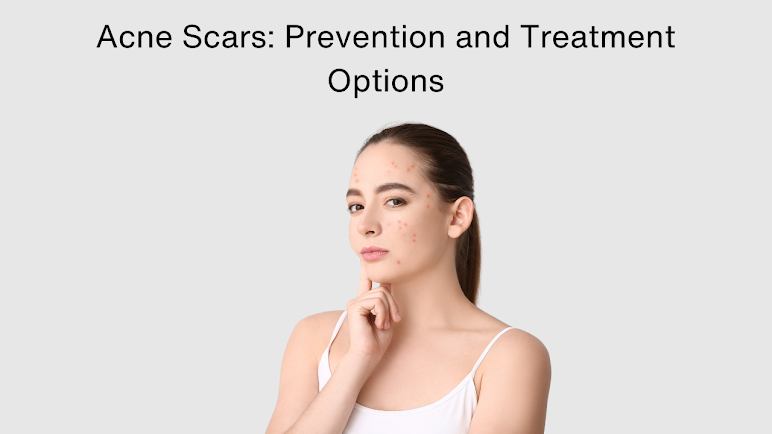Acne Scars: Prevention and Treatment Options

Welcome to the Gleuhr skin and dental clinic in Chandigarh and we provide best skin, hair and dental treatment in tricity and we also sell natural skin and hair products in all over world. We have best skin specialist in Chandigarh who are highly educated and dedicated to their work. https://clinic.gleuhr.com/

Hyperpigmentation is a common skin condition characterized by the darkening of certain areas of the skin, resulting from an excess production of melanin, the pigment responsible for skin color. While it is not a serious medical concern, hyperpigmentation can affect one's appearance and self-esteem. In this comprehensive guide, we will explore the common causes of hyperpigmentation and discuss various treatment options available to address this condition.
One of the primary causes of hyperpigmentation is prolonged and unprotected exposure to the sun's harmful ultraviolet (UV) rays. UV rays stimulate melanocytes, the cells responsible for melanin production, leading to an increase in pigment production. This can result in sunspots, freckles, and uneven skin tone. Individuals with fair skin are particularly susceptible to sun-induced hyperpigmentation, emphasizing the importance of sun protection through the regular use of sunscreen.
Hormonal fluctuations, especially during pregnancy, can trigger a specific type of hyperpigmentation known as melasma or chloasma. Often referred to as the "mask of pregnancy," melasma causes dark patches to develop on the face, typically on the forehead, cheeks, and upper lip. Hormonal changes associated with birth control pills or hormone replacement therapy can also contribute to hyperpigmentation.
Certain inflammatory skin conditions can lead to hyperpigmentation as a result of increased melanin production in response to inflammation. Conditions such as acne, eczema, and psoriasis can leave behind dark spots or patches after the inflammation subsides. Post-inflammatory hyperpigmentation can persist long after the initial skin issue has resolved, impacting the affected individual's skin tone.
Physical trauma or injury to the skin, such as cuts, burns, or abrasions, can result in hyperpigmentation during the healing process. The body may produce excess melanin as part of the skin's natural response to injury, leading to the formation of dark spots or scars. This type of hyperpigmentation is commonly seen in individuals who pick at their skin or have a history of acne.
Genetic factors can play a significant role in determining an individual's susceptibility to hyperpigmentation. Some people are naturally more prone to developing dark spots or uneven skin tone due to their genetic makeup. Understanding one's family history can provide insights into the likelihood of experiencing hyperpigmentation and help individuals take preventive measures.
Certain medications can induce hyperpigmentation as a side effect. Drugs such as nonsteroidal anti-inflammatory drugs (NSAIDs), antimalarial medications, and chemotherapeutic agents have been associated with skin discoloration. It is crucial for individuals taking medications with potential pigmentation side effects to consult their healthcare providers and explore alternative options if necessary.
As the skin ages, there is a natural decrease in collagen and elastin production, leading to thinning and increased vulnerability. Aging skin is more prone to damage from environmental factors, including sun exposure, which can contribute to the development of hyperpigmentation. Additionally, the accumulation of sun damage over time can manifest as age spots or liver spots on the skin.
Preventing further sun damage is a crucial aspect of managing hyperpigmentation. Regular use of broad-spectrum sunscreen with a high SPF can help protect the skin from harmful UV rays and prevent the exacerbation of existing pigmentation issues. Wearing protective clothing and seeking shade during peak sunlight hours are also essential sun protection measures.
Topical treatments containing ingredients like hydroquinone, retinoids, alpha hydroxy acids (AHAs), and vitamin C can be effective in treating hyperpigmentation. Hydroquinone inhibits melanin production, while retinoids and AHAs promote skin cell turnover, aiding in the removal of pigmented cells. Vitamin C is known for its brightening properties and antioxidant effects, which can help reduce the appearance of dark spots.
Chemical peels involve the application of a chemical solution to exfoliate the skin, removing the outer layer and promoting the growth of new, less pigmented skin. Various types of chemical peels, such as glycolic acid or trichloroacetic acid (TCA) peels, can be customized to target specific types of hyperpigmentation. Professional guidance is recommended to ensure the appropriate strength and application.
Laser treatments use focused beams of light to target and break down pigmented areas of the skin. This can be particularly effective for addressing specific types of hyperpigmentation, such as age spots or melasma. Different laser technologies, including intense pulsed light (IPL) and fractional lasers, offer various options for treating hyperpigmentation with minimal downtime.
Microdermabrasion involves exfoliating the skin's outer layer using a machine that sprays tiny crystals onto the surface. This process helps remove pigmented cells and stimulate the growth of new, evenly pigmented skin. While less aggressive than chemical peels or laser therapy, multiple sessions may be required to achieve noticeable results.
For severe cases of hyperpigmentation, dermatologists may prescribe medications such as stronger topical agents or oral medications. These may include corticosteroids, which can help reduce inflammation and pigmentation, or oral tranexamic acid, which inhibits melanin production. These medications are typically used under the supervision of a healthcare professional.
Hyperpigmentation is a common and often benign skin condition that can have various causes, ranging from sun exposure and hormonal changes to genetics and medication side effects. Understanding the underlying factors contributing to hyperpigmentation is essential for developing an effective treatment plan. Whether through sun protection, topical agents, professional treatments like chemical peels or laser therapy, or prescription medications, individuals have several options to address hyperpigmentation and achieve a more even skin tone. Consulting with a dermatologist can provide personalized guidance and help determine the most suitable approach for each individual's unique skin concerns.
Top of Form
Comments
Post a Comment